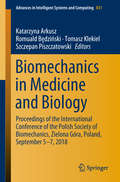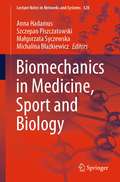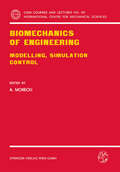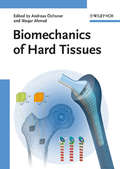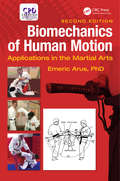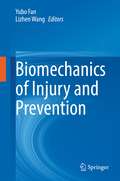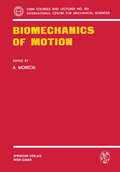- Table View
- List View
Biomechanics in Medicine and Biology: Proceedings of the International Conference of the Polish Society of Biomechanics, Zielona Góra, Poland, September 5-7, 2018 (Advances in Intelligent Systems and Computing #831)
by Szczepan Piszczatowski Tomasz Klekiel Romuald Będziński Katarzyna ArkuszThis book presents the proceedings of the “International Conference of the Polish Society of Biomechanics – BIOMECHANICS 2018” held in Zielona Góra, Poland from September 5 to 7, 2018, and discusses recent research on innovations in biomechanics.It includes a collection of selected papers in all key areas of biomechanics, including cellular, molecular, neuro and musculoskeletal biomechanics, as well as sport, clinical and rehabilitation biomechanics. These themes are extremely important in the development of engineering concepts and methods to provide new medical solutions, especially in the context of an ageing population.Presenting the latest technical advances and research methods used in clinical biomechanics, this book is of interest to scientists as well as junior researchers and students of interdisciplinary fields of engineering, medical, and sports sciences.
Biomechanics in Medicine, Sport and Biology (Lecture Notes in Networks and Systems #328)
by Anna Hadamus Szczepan Piszczatowski Małgorzata Syczewska Michalina BłażkiewiczThis book contains fourteen chapters dealing with various aspects of the biomechanics of today. The topics covered are glimpses of what modern biomechanics can offer scientists, students, and the general public. We hope this book can be inspiring, helpful, and interesting for many readers who are not necessarily concerned with biomechanics daily.
Biomechanics in Oncology (Advances in Experimental Medicine and Biology #1092)
by Cheng Dong Nastaran Zahir Konstantinos KonstantopoulosThis book covers multi-scale biomechanics for oncology, ranging from cells and tissues to whole organ. Topics covered include, but not limited to, biomaterials in mechano-oncology, non-invasive imaging techniques, mechanical models of cell migration, cancer cell mechanics, and platelet-based drug delivery for cancer applications. This is an ideal book for graduate students, biomedical engineers, and researchers in the field of mechanobiology and oncology.This book also:Describes how mechanical properties of cancer cells, the extracellular matrix, tumor microenvironment and immuno-editing, and fluid flow dynamics contribute to tumor progression and the metastatic processProvides the latest research on non-invasive imaging, including traction force microscopy and brillouin confocal microscopyIncludes insight into NCIs’ role in supporting biomechanics in oncology researchDetails how biomaterials in mechano-oncology can be used as a means to tune materials to study cancer
Biomechanics in Orthopedics
by Shigeo Niwa, Stephan M. Perren and Tomokazu HattoriA major part of orthopedics is the treatment of musculoskeletal diseases caused by structural disorders and mechanical breakdown of living tissue. Therefore, biomechanical consideration of static structures and dynamic mechanisms is compulsory for both diagnosis and treatment of orthopedic diseases. Previous biomechanical studies have enabled great advances in orthopedic implant technology, such as artificial joint replacement and instrumentation for spinal fusion. Consequently the importance of biomechanics is increasing more and more in daily clinical practice and development. In addition, biomaterial research into mechanical properties and tissue reactions of implant materials is certainly an important area of related study. This book is comprised of 22 papers presented at the International Seminar on Biomechanics in Orthopedics and the 17th Annual Meeting of the Japanese Society for Orthopedic Biomechanics, held in Nagoya in 1990. The volume contains full descriptions of both conventional and updated knowledge of the spine, ligaments, artificial joint replacement in the hip and knee, fracture treatment, and gait analysis, as well as biomaterials. I earnestly hope that this book will be of benefit to readers in daily clinical work and research. To close, I would like to thank profoundly the two coeditors, Prof. S.M. Perren and Mr. T. Hattori, and also a quiet supporter Mrs. J. Buchanan in Davos, for their cooperation in producing this book.
Biomechanics of Active Movement and Deformation of Cells (Nato ASI Subseries H: #42)
by Nuri AkkasCytomechanics is the application of the classical principles of mechanics in cell biology. It is an applied science concerned with the description and evaluation of mechanical properties of cells and their organelles as well as of the forces exerted by them. Thus, this topic needs a truly interdisciplinary approach, and accordingly this volume gives an up-to-date account of the current research done on cell division, mitosis, cytokinesis, cell locomotion and cell deformation during normal development and the cytoskeletal role in cell shape. Biologists, biomechanicians, biophysicists, biochemists and biomathematicians here discuss the basic concepts of mechanics and thermodynamics, emphasizing their applicability to cell activities.
Biomechanics of Anthropomorphic Systems (Springer Tracts in Advanced Robotics #124)
by Gentiane Venture Jean-Paul Laumond Bruno WatierMechanical laws of motion were applied very early for better understanding anthropomorphic action as suggested in advance by Newton «For from hence are easily deduced the forces of machines, which are compounded of wheels, pullies, levers, cords, and weights, ascending directly or obliquely, and other mechanical powers; as also the force of the tendons to move the bones of animals». In the 19th century E.J. Marey and E. Muybridge introduced chronophotography to scientifically investigate animal and human movements. They opened the field of motion analysis by being the first scientists to correlate ground reaction forces with kinetics.Despite of the apparent simplicity of a given skilled movement, the organization of the underlying neuro-musculo-skeletal system remains unknown. A reason is the redundancy of the motor system: a given action can be realized by different muscle and joint activity patterns, and the same underlying activity may give rise to several movements. After the pioneering work of N. Bernstein in the 60’s on the existence of motor synergies, numerous researchers «walking on the border» of their disciplines tend to discover laws and principles underlying the human motions and how the brain reduces the redundancy of the system. These synergies represent the fundamental building blocks composing complex movements.In robotics, researchers face the same redundancy and complexity challenges as the researchers in life sciences. This book gathers works of roboticists and researchers in biomechanics in order to promote an interdisciplinary research on anthropomorphic systems at large and on humanoid robotics in particular.
Biomechanics of Cell Division (Nato Science Series A: #132)
by Nuri AkkasThere are virtually hundreds of life scientists publishing hundreds of papers a year on numerous aspects of the cell cycle. The following are few of the topics covered: cell membrane organization, membrane components, cytoskeleton and associated proteins, cell motility, actin in dividing cells, surface modulating assemblies, microfilaments, microtubules, cleavage furrow, fusion, etc. In all these topics, lifescientists talk about, among others, the forces within the system, the motion within the system and the failure of the system. The concepts of force, motion and failure are, one way or another, all related to the structure of the cell and to the mechanics of the cell activities. When the concepts of mechanics and structure enter the problem then one has to talk about biomechanics; in this case, biomechanics of cytology which we would like to call "Cytbmechanics". However, a review of the journals, books and conference proceedings related to various aspects of cytology reveals that mechanicians have not yet entered the field of cytology at a noticeable level. Some lifescientists have indeed made use of the general principles of mechanics in their works; however, no truly interdisciplinary publication has yet appeared from the collaboration of mechanicians and lifescientists in the field of, for instance, cell division.
Biomechanics of Cells and Tissues: Experiments, Models and Simulations (Lecture Notes in Computational Vision and Biomechanics)
by Paola LeccaThe application of methodological approaches and mathematical formalisms proper to Physics and Engineering to investigate and describe biological processes and design biological structures has led to the development of many disciplines in the context of computational biology and biotechnology. The best known applicative domain is tissue engineering and its branches. Recent domains of interest are in the field of biophysics, e.g.: multiscale mechanics of biological membranes and films and filaments; multiscale mechanics of adhesion; biomolecular motors and force generation. Modern hypotheses, models, and tools are currently emerging and resulting from the convergence of the methods and phylosophycal apporaches of the different research areas and disciplines. All these emerging approaches share the purpose of disentangling the complexity of organisms, tissues, and cells and mimiking the function of living systems.The contributions presented in this book are current research highlights of six challenging and representative applicative domains of phyisical, engineering, and computational approaches in medicine and biology, i.e tissue engineering, modelling of molecular structures, cell mechanics and cell adhesión processes, cancer physics, and physico-chemical processes of metabolic interactions. Each chapter presents a compendium or a review of the original results achieved by authors in the last years. Furthermore, the book also wants to pinpoint the questions that are still open and that could propel the future research.
Biomechanics of Diarthrodial Joints: Volume I
by Van C. Mow Anthony Ratcliffe Savio L-Y. WooHistorical folklore indicates that Asklepios (circa 900 BC), the fir~t western doctor of ancient Greece, treated many patients with rheumatic diseases of 1 joints ,2. Later, Hippocrates (circa 400 BC), who claimed to have learned from Asklepios, used the term arthritis in reference to joint diseases: "When the disease of arthritis strikes, acute inflammation and pain attacks the joints of the body ... ". Indeed, arthritic joint disease dates much farther back into antiquity than Asklepios. Many modern anthropologists have noted degenerative joint disease in the fossils of Neanderthal man (archanthropus europeus petraloniensis) and even in those of dinosaurs. More recent scientific studies on joints date back to the work of the great English anatomist Hunter who wrote "The Structure and Diseases of Articular Cartilage" in the Philosophical Transactions of London in 1743. The notion that osteoarthritis results from the wearing away of cartilage was copiously documented by the histological observations of the German physician Ecker in 1843. This idea was further supported by Pommer (1927) who felt that mechanical stresses played important roles in the initiation and propagation of cartilage lesions leading to osteoarthritis. This same conclusion was reached by the assembled distinguished experts at a National Institutes of Health Workshop 3 held in 1986 .
Biomechanics of Engineering: Modelling, Simulation, Control (CISM International Centre for Mechanical Sciences #291)
by Adam MoreckiBiomechanics of Hard Tissues: Modeling, Testing, and Materials
by Andreas 214 Chsner Waqar AhmedThis monograph assembles expert knowledge on the latest biomechanical modeling and testing of hard tissues, coupled with a concise introduction to the structural and physical properties of bone and cartilage. A strong focus lies on the current advances in understanding bone structure and function from a materials science perspective, providing practical knowledge on how to model, simulate and predict the mechanical behavior of bone. The book presents directly applicable methods for designing and testing the performance of artificial bones and joint replacements, while addressing innovative and safe approaches to stimulated bone regeneration essential for clinical researchers.
Biomechanics of Hard Tissues: Modeling, Testing, and Materials
by Andreas Öchsner Waqar AhmedThis monograph assembles expert knowledge on the latest biomechanical modeling and testing of hard tissues, coupled with a concise introduction to the structural and physical properties of bone and cartilage. A strong focus lies on the current advances in understanding bone structure and function from a materials science perspective, providing practical knowledge on how to model, simulate and predict the mechanical behavior of bone. The book presents directly applicable methods for designing and testing the performance of artificial bones and joint replacements, while addressing innovative and safe approaches to stimulated bone regeneration essential for clinical researchers.
Biomechanics of Human Motion: Applications in the Martial Arts, Second Edition
by Emeric Arus, Ph.D.This book covers the general laws governing human biomechanics through an extensive review of martial arts techniques and references to fundamental theory. Using straightforward mathematics and physics, this work covers indepth the anatomical foundation of biomechanics and physiological foundation of human motion through specific and relevant martial arts applications. This book also covers the kinematics and kinetics of biomechanics via examples from martial arts and their comparison to different sports techniques. It is written to be used and referenced by biomechanical professionals and martial arts enthusiasts.
Biomechanics of Human Motion: Applications in the Martial Arts, Second Edition
by Emeric Arus, Ph.D.This book covers the general laws governing human biomechanics through an extensive review of martial arts techniques and references to fundamental theory. Using straightforward mathematics and physics, this work covers indepth the anatomical foundation of biomechanics and physiological foundation of human motion through specific and relevant martial arts applications. This book also covers the kinematics and kinetics of biomechanics via examples from martial arts and their comparison to different sports techniques. It is written to be used and referenced by biomechanical professionals and martial arts enthusiasts.
The Biomechanics of Impact Injury: Biomechanical Response, Mechanisms of Injury, Human Tolerance and Simulation
by Albert I. KingThis text acquaints the reader on the biomechanics of injury to the human body caused by impact and the use of computer models to simulate impact events. It provides a basic understanding of the biomechanics of the injuries resulting from the impact to the head, neck, chest, abdomen, spine, pelvis and the lower extremities, including the foot and ankle. Other topics include side impact, car-pedestrian impact, effectiveness of automotive restraint systems and sports-related injuries. Featuring problems and PowerPoint slides for lectures, the volume is ideal for students in graduate programs in biomechanics, as well as practicing engineers, and researchers in the life sciences concerned with orthopedics.
Biomechanics of Injury and Prevention
by Yubo Fan Lizhen WangThis book summarizes the recent advancements for biomechanics of injury and prevention in mechanism, application and developing frontiers. Biomechanics plays an important role in achieving safety, health, comfort, and a high quality of life by revealing injury mechanism and providing prevention methods. The book covers injury and prevention to the entire human body, from head to toe, including injury and prevention in sports, traffic, accident, clinic and so on. In addition, bionics prevention method inspired by woodpecker is also introduced. The book provides the reader with not only the mechanism of injury but also the advanced injury diagnosis, treatment, and prevention devices based on biomechanics.
Biomechanics of Soft Tissue in Cardiovascular Systems (CISM International Centre for Mechanical Sciences #441)
by Gerhard A. Holzapfel Ray W. OgdenThe book is written by leading experts in the field presenting an up-to-date view of the subject matter in a didactically sound manner. It presents a review of the current knowledge of the behaviour of soft tissues in the cardiovascular system under mechanical loads, and the importance of constitutive laws in understanding the underlying mechanics is highlighted. Cells are also described together with arteries, tendons and ligaments, heart, and other biological tissues of current research interest in biomechanics. This includes experimental, continuum mechanical and computational perspectives, with the emphasis on nonlinear behaviour, and the simulation of mechanical procedures such as balloon angioplasty.
Biomechanics of Soft Tissues: Principles and Applications
by Adil Al MayahThe emerging paradigm of incorporating images and biomechanical properties of soft tissues has proven to be an integral part of the advancement of several medical applications, including image guided radiotherapy and surgery, brachytherapy, and diagnostics. This expansion has resulted in a growing community of medical, science, and engineering professionals applying mechanical principles to address medical concerns. This book is tailored to cover a range of mechanical principles, properties, and applications of soft tissues that have previously been addressed in various journals and "anatomical site-specific" books. Biomechanics of Soft Tissues follows a different approach by offering a simplified overview of widely used mechanical models and measuring techniques of soft tissue parameters. This is followed by an investigation of different medical applications, including: biomechanical aspects of cancerous tumor progressions, radiotherapy treatment, and image guided ultrasound guided interventions. Written by leading scholars and professionals in the field, Biomechanics of Soft Tissues combines engineering and medical expertise, thereby producing an excellent source of information for professionals interested in the theoretical and technological advancements related to soft tissues. The book provides medical professionals with an insight on various modeling approaches, testing techniques, and mechanical characteristics that are frequently used by engineers. Conversely, the presented medical applications provide engineers with a glimpse of amazing medical practices and encourage them to expand their roles in the medical field. Provides a simplified overview of mechanics of soft tissues. Highlights different techniques to measure tissues properties for engineering and medical applications. Contains novel ideas to address roles of mechanics in disease progression and treatment. Presents innovative applications of biomechanics in medical procedures.
Biomechanics of Soft Tissues: Principles and Applications
by Adil Al MayahThe emerging paradigm of incorporating images and biomechanical properties of soft tissues has proven to be an integral part of the advancement of several medical applications, including image guided radiotherapy and surgery, brachytherapy, and diagnostics. This expansion has resulted in a growing community of medical, science, and engineering professionals applying mechanical principles to address medical concerns. This book is tailored to cover a range of mechanical principles, properties, and applications of soft tissues that have previously been addressed in various journals and "anatomical site-specific" books. Biomechanics of Soft Tissues follows a different approach by offering a simplified overview of widely used mechanical models and measuring techniques of soft tissue parameters. This is followed by an investigation of different medical applications, including: biomechanical aspects of cancerous tumor progressions, radiotherapy treatment, and image guided ultrasound guided interventions. Written by leading scholars and professionals in the field, Biomechanics of Soft Tissues combines engineering and medical expertise, thereby producing an excellent source of information for professionals interested in the theoretical and technological advancements related to soft tissues. The book provides medical professionals with an insight on various modeling approaches, testing techniques, and mechanical characteristics that are frequently used by engineers. Conversely, the presented medical applications provide engineers with a glimpse of amazing medical practices and encourage them to expand their roles in the medical field. Provides a simplified overview of mechanics of soft tissues. Highlights different techniques to measure tissues properties for engineering and medical applications. Contains novel ideas to address roles of mechanics in disease progression and treatment. Presents innovative applications of biomechanics in medical procedures.
Biomechanics of the Brain (Biological and Medical Physics, Biomedical Engineering)
by Karol MillerBiomechanics of the Brain will present an introduction to brain anatomy for engineers and scientists. Experimental techniques such as brain imaging and brain tissue mechanical property measurement will be discussed, as well as computational methods for neuroimage analysis and modeling of brain deformations due to impacts and neurosurgical interventions. Brain trauma between the different sexes will be analyzed. Applications will include prevention and diagnosis of traumatic injuries, such as shaken baby syndrome, neurosurgical simulation and neurosurgical guidance, as well as brain structural disease modeling for diagnosis and prognosis.This book will be the first book on brain biomechanics. It will provide a comprehensive source of information on this important field for students, researchers, and medical professionals in the fields of computer-aided neurosurgery, head injury, and basic biomechanics.
Biomechanics of the Brain (Biological and Medical Physics, Biomedical Engineering)
by Karol MillerThis new edition presents an authoritative account of the current state of brain biomechanics research for engineers, scientists and medical professionals. Since the first edition in 2011, this topic has unquestionably entered into the mainstream of biomechanical research. The book brings together leading scientists in the diverse fields of anatomy, neuroimaging, image-guided neurosurgery, brain injury, solid and fluid mechanics, mathematical modelling and computer simulation to paint an inclusive picture of the rapidly evolving field.Covering topics from brain anatomy and imaging to sophisticated methods of modeling brain injury and neurosurgery (including the most recent applications of biomechanics to treat epilepsy), to the cutting edge methods in analyzing cerebrospinal fluid and blood flow, this book is the comprehensive reference in the field. Experienced researchers as well as students will find this book useful.
Biomechanics of the Gastrointestinal Tract: New Perspectives in Motility Research and Diagnostics
by Hans GregersenBiomechanics of the Gastrointestinal Tract is an up-to-date book for researchers on the study of the mechanical properties and the motor system of the gastrointestinal tract. A well-illustrated book, it provides a comprehensive overview to relevant tissue geometry, morphology and biomechanical theory. Separate chapters cover smooth muscle and nerve function including the application to animal and human studies of motility, symptoms and pain, determination of the true resting state, history-dependent properties, and tissue remodelling in disease. Several methods and diagnostic applications such as determination of in vivo length-tension diagrams and multimodal pain testing are completely new but will undoubtedly be used by many in the future. New non-invasive imaging techniques based on ultrasound, MR- and CT-scanning in combination with balloon distension are emerging as the techniques for future in vivo studies.
Biomechanics of the Human Body (Undergraduate Lecture Notes in Physics)
by Emico Okuno Luciano FratinBiomechanics of the Human Body teaches basic physics concepts using examples and problems based on the human body. The reader will also learn how the laws of mechanics may help to understand the conditions of the static and dynamic equilibrium of one of the marvels of nature: the human body. The mathematical language used in physics has always been pointed out as responsible for students’ difficulties. So, each concept given is followed by explanatory examples, with subsequent application and fixation exercises. It is a richly illustrated book that facilitates the comprehension of presented concepts. Biomechanics of the Human Body can be useful to students of physical and occupational therapy, physical education, the life sciences, and health care professionals who deal with biomechanics. This book is also recommended for sport practitioners as well as the general reader interested in the mechanics of the human body.
The Biomechanics of the Tactile Perception of Friction (Springer Series on Touch and Haptic Systems)
by Laurence WillemetHumans rely on their sense of touch to perceive subtle movements and micro slippages to manipulate an impressive range of objects. This incredible dexterity relies on fast and unconscious adjustments of the grip force that holds an object strong enough to avoid a catastrophic fall yet gentle enough not to damage it. The Biomechanics of the Tactile Perception of Friction covers how the complex mechanical interaction is perceived by the nervous system to quickly infer the state of the contact for a swift and precise regulation of the grip. The first part focuses on how humans assess friction at the contact initialization and the second part highlights an efficient coding strategy that the nervous system might use to continuously adjust the grip force to keep a constant safety margin before slippage. Taken together, these results reveal how the perception of frictional information is encoded in the deformation of our skin. The findings are useful for designing bio-inspired tactile sensors for robotics or prosthetics and for improving haptic human-machine interactions.
